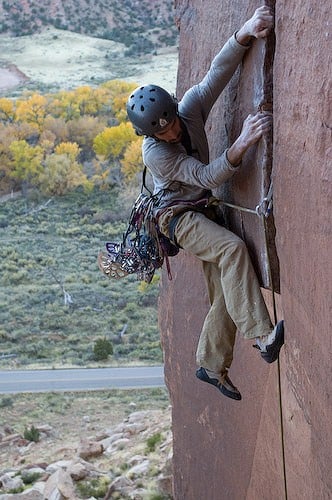
Few rock climbing destinations have as unforgiving climbing as Indian Creek. Away from the security of sharp corners, climbers without jamming skills are nowhere bound. Smooth red desert sandstone offers nothing but clean-cut fissures, separated by swaths of absolute blank rock. Face climbing skills are nigh-on irrelevant, and before you have mastered any given width of crack, every single move on cracks of that width is equally impossible. Indian Creek is probably the best place to practise the basic skills of crack climbing.
Last autumn I made my first pilgrimage to the sacred home of the splitter. My travel companion Pär, who had been to Indian Creek before‚ had warned me that the climbing in Indian Creek was like nowhere else. And when we rolled into the pullout beneath the famous Supercrack Buttress early the first morning we ran into a Yosemite/Patagonia legend and seasoned desert climber who, when he found out that this was my first visit, gleefully told me that I was about to have a few hard days. And right they where.
I decided to start off with a hand crack. I like hand cracks. I've never fallen off a hand crack anywhere in the world. When the thumb is folded in and rests against the palm the hand forms a perfect wedge. The foot jam is incredibly secure. The only way to fall off a hand crack is by letting go on purpose.
On the first route I did at The Creek, the aptly named Generic Crack, 120 feet of flared hands, the last statement in the paragraph above was almost falsified. On the slick red sandstone in the desert I had to let the jams slide down a bit before they caught, but at first my granite-schooled hands refused to let that happen, so, out of shear panic, I used way more force than necessary. I was quite happy when I reached the anchors since by that point I was out of both gear and of all fitting words of theological and anatomical nature. A more relaxed, skidding style was clearly needed.
There are no moderates in The Creek. Red desert sandstone offers no respite, few rests, and no gentle slabby terrain. The easiest routes often offer 60 to 120 feet of perfect hand-jams on vertical rock, and at first those where hard enough.
I suppose most of us who go to Indian Creek follow the same path to knowledge. Hand cracks first, then wide hands, then thin hands. For a while thin hands were hard enough. After I finally gained some confidence on friend #2 sized cracks, I discovered that I couldn't do one single move when the crack tapered off to ratchets, ring locks, and other kinds of fingerstacking shenanigans‚ especially if the crack was offset. After someone demonstrated the ringlock/karate-chop combo for me, I could do one or two moves. With a bit of practice I could do a few more, and then suddenly every move went from impossible to possible. These kind of sudden realisations, almost epiphanies, that a certain size is not impossible at all, but rather quite easy is one of the main attractions of desert climbing.
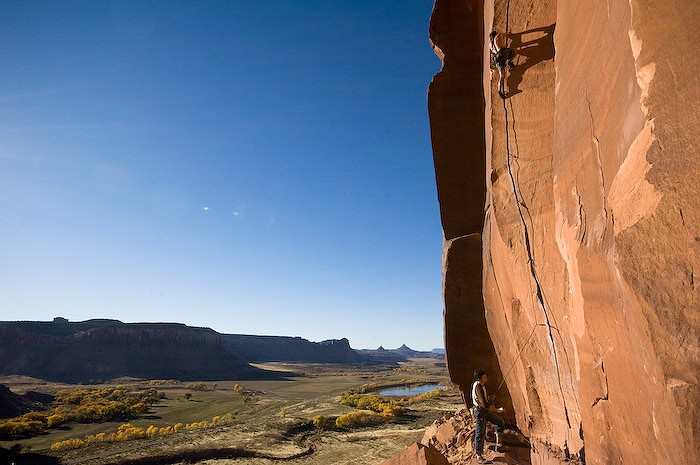
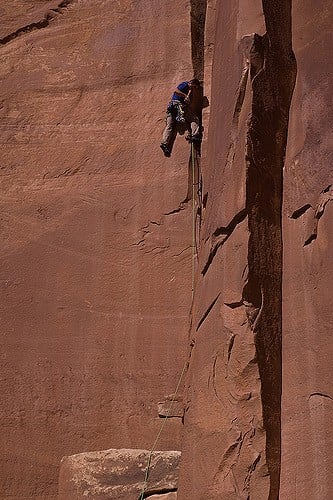
The first day of our trip we met Paco, a Spanish climber who was looking for partners. That was a good thing, since it take approximately three European trad climbers' racks to build one functioning desert rack. Desert sandstone is friable. They tell you to place a piece every body length to safely protect a route. Since routes are often sustained in a certain size, the leader needs a huge rack.
I am a clumsy climber, trained as a sport climber, and tend to try to get out of trouble by climbing upwards. Apart from the clumsiness, Paco is much the same. Together we did a fair amount of falling, on relatively small gear too. Thus we can vouch for the sturdiness of dark red desert-varnished Wingate sandstone. Granite it isn't, but after a week with some proper falls I was sure that the warnings about the snappishness of desert sandstone where quite exaggerated.
Alas, I found out the possible consequences of falling on small gear when the stone has a lighter colour: on a crumbly tips crack I ripped three aliens straight out of the crack and hit the ground. But in a nice way.
While it is true that there are no easy routes in Indian Creek, there are no hard routes either. There are few overhanging routes, and most roofs are shorter than a body length. Because of this lack of steepness the hardest cracks are no harder than 5.13a/b. These routes tend to be either thin tips-cracks with nothing for feet, or cracks with better feet but featuring sustained awkward finger-stacking.
And, while it is true that some routes have extraordinary long sections on which the cracks never vary in size, there are quite a few routes where the crack do vary in size. Many of my favourite routes are indeed the ones which taper off or widen gradually and therefore demand a variety of techniques. Cap this with a roof at the top and you have some of my favourite routes anywhere.
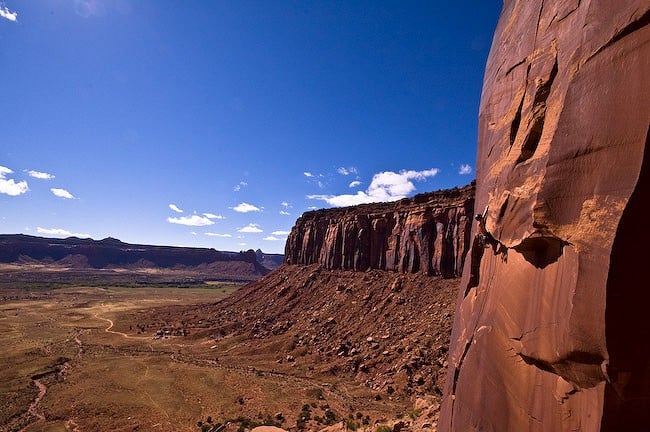
Getting there

Staying there
Camping in Indian Creek is still free. However, everything - including human waste, needs to be packed out. Re-use established camping sites and do not open new ones. The best information about camping is obtained via Bureau of Land Management's Monticello Field Office on the address www.blm.gov/utah/monticello
If you decide to camp, bring lots and lots of water.
I am not a big fan of camping, and since there are no facilities down in the corridor anyway we opted to stay in a cabin in Monticello, 45 min from Supercrack buttress. We rented a frugal cabin by the week at Bar-TN RV park, and where quite happy with that place more lodging can be found on the address http://www.discoverourtown.com/UT/Monticello/
Monticello is a small backwater town. Apart from surfing the Internet for free at the public library (they have wi-fi too) and sipping overpriced lattes at Peace Tree, the "hippie cafe" there is absolutely nothing to do. Half the houses are remodelled trailers, but they have a prominent temple of The Church of Jesus Christ of Latter-day Saints. During the month we stayed there three people where seen using walking as a mode of transport: me, my climbing partner, and a vagrant. If such places makes you uncomfortable you are better off staying in Moab, about an hour from The Creek. Accommodation options are much more expensive in Moab though.
Season
Autumn: From mid-September to mid-November with temperatures ranging from 30 C down to 10 C. Below freezing during night from late October.
Winter: Not recommended for anything else than a weekend trip following a good forecast. Frequent snowstorms. I know a guy who hitched in and got stuck alone down in the valley following a snowstorm, and didn't manage to find a ride out for quite a while.
Spring: March to late April. Less stable weather than during autumn.
Summer: Out of question.
Guidebook
Indian Creek - A Climbing Guide by David Bloom is the only dedicated guidebook to Indian Creek. A well researched and beautiful guidebook. A lot of information, maybe a tad too much really, about routes at The Creek can be gained from browsing www.mountainproject.com
Gear:
Shoes
Modern face-climbing shoes, in which the foot is crammed into a slightly banana-shaped shoe in order to gain precision on edges and pockets, are rubbish, extremely painful, and totally useless. A good shoe for pure crack climbing need to be big enough so that the toes lay flat inside the shoe. My crack-climbing shoes are two to two-and-a-half sizes bigger than my face climbing shoes.
For hand cracks and bigger any shoe will do. Even approach shoes are OK, certainly better than super-tight-fitting climbing shoes anyway. For thinner cracks a low-profiled board-lasted shoe or a classic flat slipper works well. La Sportiva Mythos and 5.10 Moccasym are the two most popular shoes among the Canyonlands aficionados, but anything along those lines work well. If your footwork is shoddy the crack will eat up the shoelaces in just a few pitches.
Cams
It is not unusual to start up a route carrying seven cams of the same size. On Tricks Are For Kids, the guidebook recommends twelve Wild Country Friend 1.5's. On easier routes it is possible to leapfrog protection. I wouldn't exactly try that on Tricks...
Almost everyone you meet will be willing to lend and borrow gear.
Bring most cams in the size crack you want to climb. (Duh)
When boarding a flight in the US you can bring your cams and crabs with the carry on luggage. Unfortunately you have to check them when boarding in EU-land.
Tape
Gobies are disgusting. On routes with sustained hand jamming only people who love self-inflected pain or climbers operating way below their standard abstain from taping. Learn how to make a tape glove and bring lots of tape.
Grades
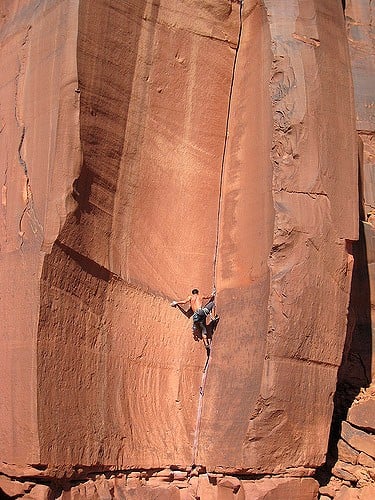
- Wide hands: 5.10+ to 5.11
- Perfect hands: 5.9 to 5.10
- Thin hands: 5.11- to 5.12-
- Fingerstacks: 5.12- to 5.13
- Fingers: 5.11+ to 5.12+
- Tips: 5.12 to 5.13-
The key to most routes is to climb quickly and efficiently. Placing gear is often the hardest part. Therefore a top rope will lower the physical difficulty of a climb quite a lot. Long run-outs caused by an inordinate amount of confidence also hack off a few grades of the rating.
Women with small size hands will find that routes graded 5.11- and protected by mostly friend #2 are way easier than the routes protected by mostly friend #2.5 and #3 graded 5.10. On the other hand routes graded 5.11- protected by mostly friend #3 or #3.5 will be a long bloody battle for women with small hands, while they are easy for us with huge hands. So don't stare blindly at just the grade when looking for routes to learn on.
Keep in mind that the routes at The Creek are "sport trad": protection is obvious, the routes are (mostly) safe. And figuring out the sequence is not an issue. Comparing YDS grades for cracks with other grading systems is a bit silly since European geology offers very few pure stamina splitters. However, a fit E1-leader who knows how to jam should be perfectly capable of doing cracks with perfect hands.
Recommended routes
There are so many excellent routes to climb. You absolutely cannot go wrong with the routes recommended in the back of Bloom's guidebook. The routes I mention below are far from being among the best routes, but they are still very good, and possible to climb without testing jamming skills too hard, so when you are tired of getting trashed by straight in cracks do the following:
Annanuki, the classic tick for sportclimbers since most of this overhanging zig-zagging crack is climbed using face-climbing techniques.
Tips crack, thin but not to sustained laybacking up an immaculate corner.
Battle of the Bulge, possible to layback at pretty much the same grade as climbing it straight in.
Fingers in a Light socket. Yet another classic layback. For the strong climber I hear that Ruby's crack is mostly laybacking and easy for the grade.
Training
I will be better prepared next time I go to Indian Creek. To that end, I have built an adjustable crack machine by bolting two 2x4s together. I put in two threaded rods every three feet and made the crack adjustable. I believe that the low friction between wood and skin makes it a good simulator for the slick rock in Indian Creek.
Other over-seas UKC destination articles include:
Todra Gorge - Moroccan climbing by Glyn Jones
Arco - Italian Sport Climbing Mecca by Jack Geldard - Editor
Clark Mountain - the best limestone in America by Randy Leavitt
Ogliastra – A Sardinian year-round climbing paradise by Peter Herold
Thank you to Jonas for contributing the article and photographs to UKClimbing.com

Comments